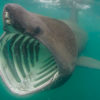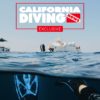On my last dive trip to San Diego, I found myself sitting over the Yukon wreck preparing for my umpteenth obligatory dive on the sunken ship. Don’t get me wrong—I love diving the Yukon. And I have yet to fully explore the wreck (especially the inside). But this was a photo trip and had wide-angle photoed this ship upside down (actually sideways because that is the way she lays) and backwards. Great shots of the gun turrets, bow, divers in hatchways and more, but I wanted something different. Then I spotted my macro setup in my camera case that was supposed to be used for the second dive in the kelp.
I had not been on the wreck in six months and heard that the growth had greatly accelerated with numerous invertebrates showing up on the ship that has now been on the bottom almost two years. I went for broke and put the macro camera together and headed for the bottom with it in hand and high hopes. I was not disappointed.
Water visibility on the Yukon is highly variable ranging from 50 feet and as little as 10, usually due to plankton blooms. When the water turns green, you often don’t know you’re on the wreck until you hit it. This is how it was this day but this time I had my macro camera in hand so I didn’t care. I was here to enjoy the Yukon from a whole new perspective.
While the Yukon is still not the macro photographer’s paradise that the other wrecks in San Diego “Wreck Alley” (the Ruby E, El Rey and NOSC Tower, all of which have been down much longer), there was much to photograph.
The biggest surprise and delight was the white plume metridium anemones. While these anemones are common, they only like very cold water and consequently usually only found 100 feet and deeper in Southern California (most of the Yukon wreck is less than 100 feet). These fluffy white anemones stand three to seven inches tall and can be difficult to photograph because of their snow white color. Bracket your exposures to bring out detail and the subtle colors such as cream and yellow. You will find scattered patches of these anemones on the underside of the forward and stern gun turrets and on the rear wall of the superstructure. Individual animals can be found elsewhere here and there.
A much more common anemone but still worth photography is the strawberry or corynactis anemone. The nearby wreck Ruby E is blanketed in a patchwork of these animals that look like tiny lavender flowers. Eventually, the Yukon will be covered as well but for now patches are appearing here and there, large enough for photos.
The Yukon has turned into the best wreck in Wreck Alley for nudibranch photography both in variety and quantity (although to be fair perhaps the Yukon has more nudibranchs simply because, at 366 feet long, it is so much bigger!). Look for California Berthella, a dorid shaped slug that comes in two color phases. The light phase is white cream colored with white spots and outlined with bright white. The dark phase shows the animal in a warmer pink or rose. Sometimes you see these simple animals that have both sex organs mating on the wreck, side by side with their mantles curled up against each other. The feathery Triton family of nudibranchs are also making an appearance in numbers. The best area on the wreck for finding nudibranchs is the “props” on the stern although they can be found all over the wreck.
Inside the wreck, scorpionfish have taken up residence. You don’t need to penetrate the wreck far to photograph this colorful fish with grouchy faces. You will, however, need a modeling light because they are often in dark corners that make it difficult to frame and focus your photo.
Because the Yukon is in an open ocean location, surge is always present. While this is generally not a problem during normal diving activities, it can drive the macro photographer crazy. To escape the worst effects of the surge, head deeper and more protected areas of the wreck.
With time, Mother Ocean will continue to decorate the Yukon with more and more colorful invertebrates and tiny fish to make macro photography on the wreck increasingly profitable. Consider it on your next Yukon photo dive.
Dive Spot At A Glance
Location: Two miles of Mission Beach, San Diego. Marked by as many as four mooring buoys (depending on how many are intact and in place). GPS N32°46.811′, W117°16.992′ (GPS is for reference only. Do not use as the sole source of navigation.
Access: Boat only. Many small boat launch ramps and charter boats available in very close by Mission Bay.
Skill Level: Intermediate or better. Interior penetration for specially trained divers only.
Depths: Just over 100 feet to the bottom, but much of the wreck is 90 feet or less.
Visibility: Variable between 10 and 50 feet with 30 feet average.
Photography: Good wide angle of divers on wreck in days with good viz. Increasingly better for macro as the wreck ages and gains life.
Hunting: None in “Wreck Alley” as per gentlemen’s agreement. Very little to hunt anyway.
Hazards: Deep water. Dangerous wreck penetration for the untrained. Surge on top of wreck and near the openings.






